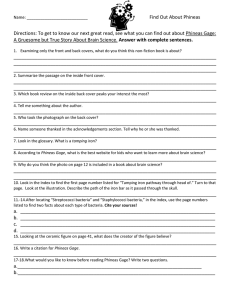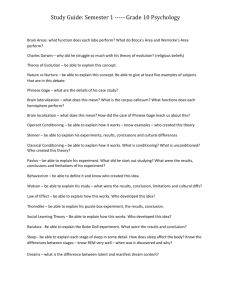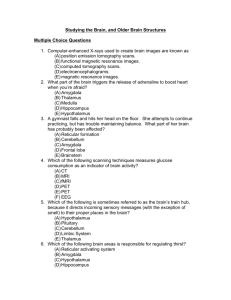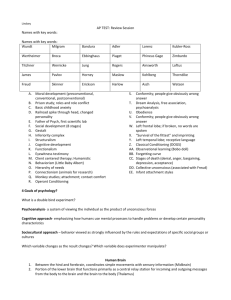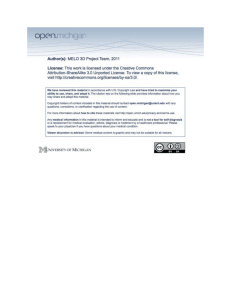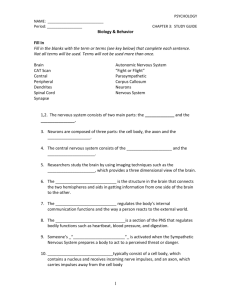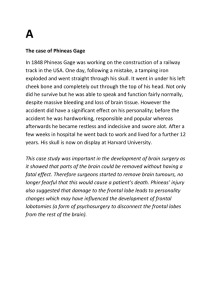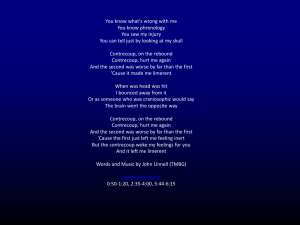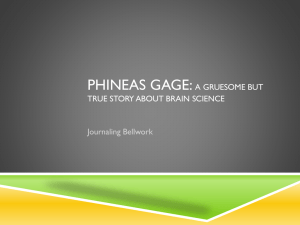The Brain
advertisement
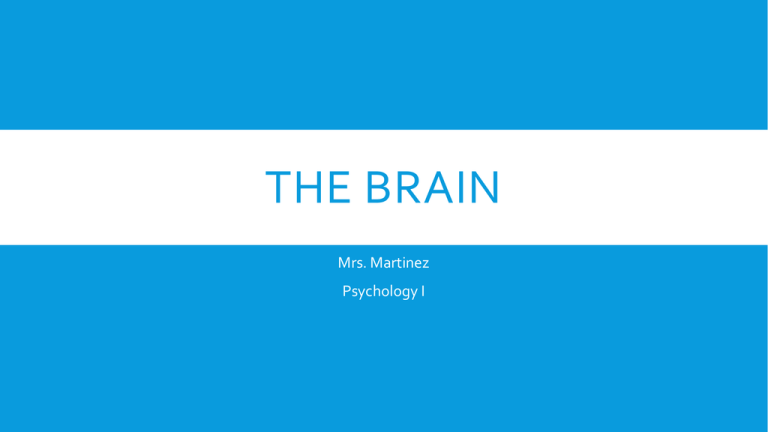
THE BRAIN Mrs. Martinez Psychology I CENTRAL NERVOUS SYSTEM A. Brain B. Spinal Cord a. Spinal Reflexes- simple automatic responses to something. PERIPHERAL NERVOUS SYSTEM Somatic Nervous System- Enables us to experience sensations such as hot or cold. Alerts us that parts of the body have changed position. Helps to maintain balance and posture PERIPHERAL NERVOUS SYSTEM Autonomic Nervous System- Sympathetic-activated when someone is going into action because of a stressful event. (fight or flight response) Parasympathetic-restores the body’s reserves of energy after an action has occurred. Brings our body to a peaceful state THE BRAIN Composed of many parts that organize our movements, create our thoughts, form our emotions and produce our behaviors. Divided into 3 Sections: The lower level: medulla, pons and cerebellum The middle level: Limbic system which includes the amygdala, hypothalamus, thalamus and hippocampus. The outer level: the cerebrum and cerebral cortex. CEREBELLUM, MEDULLA, PONS Cerebellum: helps with balance and coordination. Known as the little brain. Medulla: lower part of the brain stem. Functions are involuntary and include Breathing, heart rate and swallowing. Pons: Sits directly above the medulla. It is a message station between cerebellum and cortex. Plays a key role in sleeping and dreaming. AMYGDALA, HYPOTHALAMUS, THALAMUS, HIPPOCMAPUS Amygdala: almond shaped. Center for many emotions specifically fear and aggression. Sits next to hippocampus Hypothalamus: Hypo means “under”, under thalamus. Very small but helps regulate thirst, body temp., hunger and blood pressure. Keeps us balanced. Thalamus: Relays motor and sensory signals to the cerebral cortex. Hippocampus: involved with establishing long term memory, Learning, and Emotion, Latin for seahorse. THE BRAIN Cerebral Cortex The part that makes us uniquely human. It is the part that thinks! Composed of 2 sides (hemispheres) Connected by the corpus callosum: a broad band of nerve fibers joining the two hemispheres of the brain. The brain is composed of 4 lobes. frontal lobe-motor functions parietal lobe-sensory area occipital lobe-primary visual area temporal lobe-auditory area THE BRAIN AND LANGUAGE ABILITIES Language abilitiesconcentrated in the left hemisphere Broca’s area-located in the frontal lobe. It enables us to move our lips when speaking. When damaged, people speak slowly and with difficulty but comprehension is good. Sarah and Broca's aphasia Wernicke’s area-located in the temporal lobe. It pieces together sounds and sights. Damage to this area makes it difficult to understand speech. METHODS OF STUDYING THE BRAIN 1. Accidents 2. Electrical stimulation of the brain 3. Electroencephalogram (EEG)-a device that studies the electrical activity of the brain. 4. SCANS CAT MRI PET PHINEAS GAGE Read “What Happened to Phineas Gage?” Answer the following questions in complete sentences: 1. Describe Phineas Gage’s accident. 2.How did Phineas Gage change after the accident? 3. How did Phineas Gage’s accident change scientists’ understanding of the brain? Video clip: Phineas Gage
